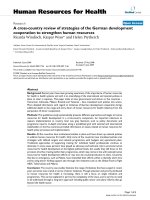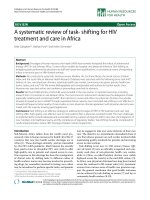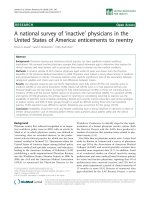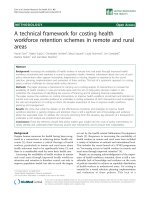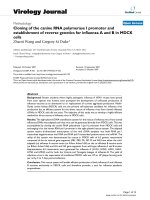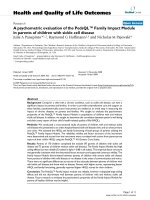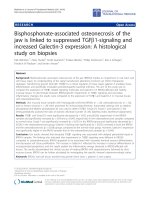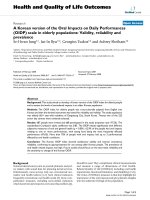báo cáo sinh học:" A cross-country review of strategies of the German development cooperation to strengthen human resources" ppt
Bạn đang xem bản rút gọn của tài liệu. Xem và tải ngay bản đầy đủ của tài liệu tại đây (243.04 KB, 8 trang )
BioMed Central
Page 1 of 8
(page number not for citation purposes)
Human Resources for Health
Open Access
Research
A cross-country review of strategies of the German development
cooperation to strengthen human resources
Ricarda Windisch, Kaspar Wyss* and Helen Prytherch
Address: Swiss Centre for International Health, Swiss Tropical Institute, Basel, Switzerland
Email: Ricarda Windisch - ; Kaspar Wyss* - ; Helen Prytherch -
* Corresponding author
Abstract
Background: Recent years have seen growing awareness of the importance of human resources
for health in health systems and with it an intensifying of the international and national policies in
place to steer a response. This paper looks at how governments and donors in five countries –
Cameroon, Indonesia, Malawi, Rwanda and Tanzania – have translated such policies into action.
More detailed information with regard to initiatives of German development cooperation brings
additional depth to the range and entry doors of human resources for health initiatives from the
perspective of donor cooperation.
Methods: This qualitative study systematically presents different approaches and stages to human
resources for health development in a cross-country comparison. An important reference to
capture implementation at country level was grey literature such as policy documents and
programme reports. In-depth interviews along a predefined grid with national and international
stakeholders in the five countries provided information on issues related to human resources for
health policy processes and implementation.
Results: All five countries have institutional entities in place and have drawn up national policies
to address human resources for health. Only some of the countries have translated policies into
strategies with defined targets and national programmes with budgets and operational plans.
Traditional approaches of supporting training for individual health professionals continue to
dominate. In some cases partners have played an advocacy and technical role to promote human
resources for health development at the highest political levels, but usually they still focus on the
provision of ad hoc training within their programmes, which may not be in line with national human
resources for health development efforts or may even be counterproductive to them. Countries
that face an emergency, such as Malawi, have intensified their efforts within a relatively short time
and by using donor funding support also through new initiatives such as the Global Fund to Fight
AIDS, Tuberculosis and Malaria.
Conclusion: The country case studies illustrate the range of initiatives that have surged in recent
years and some main trends in terms of donor initiatives. Though attention and priority attributed
to human resources for health is increasing, there is still a focus on single initiatives and
programmes. This can be explained in part by the complexity of the issue, and in part by its need
to be addressed through a long-term approach including public sector and salary reforms that go
beyond the health sector.
Published: 5 June 2009
Human Resources for Health 2009, 7:46 doi:10.1186/1478-4491-7-46
Received: 27 May 2008
Accepted: 5 June 2009
This article is available from: />© 2009 Windisch et al; licensee BioMed Central Ltd.
This is an Open Access article distributed under the terms of the Creative Commons Attribution License ( />),
which permits unrestricted use, distribution, and reproduction in any medium, provided the original work is properly cited.
Human Resources for Health 2009, 7:46 />Page 2 of 8
(page number not for citation purposes)
Background
Today there are increased awareness and consensus that
strengthening human resources for health (HRH) entails
a broad set of reforms that go beyond the training of
health staff. Important documents include the World
Health Organization's (WHO) World health report 2006
and the Joint Learning Initiative's Human resources for
health: overcoming the crisis, 2004 [1,2]. Moreover, some
global health initiatives such as the Global Fund to Fight
AIDS, Tuberculosis and Malaria have started to adapt their
agenda to account for the need to strengthen HRH [3].
This increase of awareness has, however, only to a limited
extent turned into broader support by bilateral and multi-
lateral agencies to strengthen HRH at country level. There
is still little information on how countries actually address
HRH development [4]. There is also little information on
initiatives and roles of donor cooperation in the context
of HRH development.
To address these issues, this paper reviews country initia-
tives for HRH in five low-income countries: Cameroon,
Indonesia, Malawi, Rwanda and Tanzania. It outlines the
situation with regard to HRH in general in those countries
and then provides additional detail on initiatives by Ger-
man development cooperation. German development
cooperation was chosen as a relatively large donor that
has initiated a stronger focus on initiatives to strengthen
HRH.
With regard to the institutions of German development
cooperation subject to this review: German Technical
Cooperation (GTZ), with its 67 country offices, is the
main technical implementing agency on behalf of the
German Federal Ministry for Economic Cooperation and
Development (BMZ). In the programme-based approach,
GTZ focuses upon technical assistance, while the German
Development Bank (Kreditanstalt für Wiederaufbau) com-
plements with financial assistance through a mix of
modalities including budget support or basket fund con-
tributions. The German Development Service (DED) pri-
marily places expatriate technical expertise at regional and
district level in around 40 partner countries. The main
objective of the institution Capacity Building Interna-
tional (InWEnt) is to support capacity building in devel-
oping countries, including building up and supporting
training institutions, facilitating continuous and on-the-
job training, etc. The Centrum for International Migration
(CIM) is a joint operation of the GTZ and the German
Federal Employment Agency (BA) that enables develop-
ing countries to recruit senior and qualified staff from the
European Union at a local salary that is topped up by
CIM. Not a typical actor in the frame of development
cooperation, the German Academic Exchange Service
(DAAD) plays a role with regard to HRH in developing
countries, given that it facilitates study and research stays
in Germany and supports reintegration of scholars in low-
income countries through incentives such as continuous
education and alumni networks.
Countries included in this study vary considerably with
regard to HRH density. Malawi has by far the lowest rates
of physician density, followed by Tanzania and then
Rwanda (Table 1). Cameroon and Indonesia are facing
less critical shortages. These two countries, followed by
Tanzania, also have the highest aggregated rates of nurses
and other auxiliary health workers (Table 1).
All five countries face similar causes for their shortages,
including brain drain to the private sector and other coun-
tries, low salaries, poor working conditions and insuffi-
cient training capacities. Cameroon, Malawi and Tanzania
were particularly affected by public sector freezes as part of
structural adjustment programmes initiated and sup-
ported by the World Bank and the International Monetary
Fund during the 1980s and 1990s. Large-scale emigration
of skilled staff and loss of health staff compounded by a
high TB and AIDS burden is most pronounced in Malawi
[5-7]. All five countries face unequal staff densities
between rural and urban areas. In Rwanda, an estimated
Table 1: Health workers in public services per 1000 people
Indicator (per 1000 population) Cameroon
(2004)
Indonesia
(2003)
Malawi
(2004)
Rwanda
(2004)
Tanzania
(2002)
Physicians 0.19 0.13 0.02 0.05 0.02
Nurses 1.60 0.57 0.59 0.42 0.30
Midwives 0.00 0.25 N.A. 0.01 0.07
Other health workers 0.00 0.10 0.06 0.06 0.82
Health management and support workers 0.36 1.04 N.A. 0.10 0.02
Source: WHO Statistical Information System (WHOSIS), consulted online at 12.02.08
Human Resources for Health 2009, 7:46 />Page 3 of 8
(page number not for citation purposes)
75% of doctors and 50% of nurses currently work in
Kigali. In Tanzania, where 66% to 80% of the total popu-
lation live in rural areas, only one third of physicians work
in rural areas [8].
Methods
We selected the five countries as they represent different
regions (Asia and Central and East Africa) with diverse set-
tings and challenges for addressing HRH. In addition,
they are focus countries of German development health
programmes. The information was assembled through a
literature review and by interviewing more than 40 repre-
sentatives from the five agencies working in the five study
countries in the frame of German development coopera-
tion; representatives from other bilateral and multilateral
agencies were also interviewed. All interviews were based
on a guide to assure standardized data across countries.
Interviews were conducted between September and
November 2006 by the authors of this study. The informa-
tion was complemented by a literature review including
both peer-reviewed and grey literature. Grey literature
included national policy documents, programme reports
and evaluations to assess priority setting and implementa-
tion of initiatives at country level. The corpus of grey liter-
ature was assembled primarily through the network of
country representatives interviewed in the course of this
study.
The largely qualitative data was transcribed and analysed
along a pre-established grid. Interventions were grouped
according to stages and components that together consti-
tute a national response to HRH development. This
included looking at how far country initiatives include
setting up institutions and policies at national and inter-
national level, pre-service and continuous training and
other financial and non-financial incentives, as well as
increasing the quantity of staff through recruitment of
external staff and reintegration of national health person-
nel from abroad. Results and outcomes of these initiatives
are structured along this framework and are presented in
the next section.
Results and discussion
Policy context
All countries except Malawi have decentralized the man-
agement of HRH. In Indonesia decentralization contrib-
uted to an increase in regional inequity of available health
staff, with a range of one- to five-fold due to unequal dis-
trict planning capacities and incentive structures [9,10].
Initiatives in Malawi were to strengthen regional technical
support structures for HRH. The German Cooperation has
contributed to this initiative by placing regional support
staff.
Most of the five countries studied have extensive private
sectors. In Malawi, 37% of health service provision
isthrough church-based health facilities under the Chris-
tian HealthAssociation of Malawi (CHAM). Working con-
ditions at CHAM are generally judged as better than in the
public sector [11]. Similarly, Cameroon has an important
private health sector, partly originating from an economic
crisis that triggered a public sector employment freeze and
a 50% reduction of public salaries [12-14]. Skilled health
workers trained in the public sector often remain unem-
ployed or seek jobs in the private sector [15]. The national
effort to increase salaries for health workers in Malawi
included provision for CHAM staff.
Overall, this study has found few important initiatives in
the five countries to address the issue of public/private
sector regulation. One exception is the SETP programme,
explained below, which aims to improve nurse training
through public-private partnership between the Malawian
government and CHAM, which owns many of the training
institutions [5]. Another example is in Tanzania, where
GTZ supported the Ministry of Health's effort to address
dual practice in private and public services by formally
allowing higher cadres to work in both sectors [16].
All five countries identified HRH development as a signif-
icant component of health sector reforms and established
HRH taskforces or boards within the ministry of health
(MoH). How far HRH policies are based on needs assess-
ments and are budgeted and translated into operational
targets differs between the countries. In Tanzania, where
HRH is one of the nine strategies of the health sector
reform programme, a strategic plan to address HRH was
under development at the time of the review. Cameroon
has only recently started to attribute some priority to HRH
within its health policy; HRH is intended to receive more
attention within the health policy for 2008–2015. The
country has developed strategies for training, career devel-
opment and a standardized distribution of staff, but those
are largely not known and implemented at district level.
Malawi, Indonesia and Tanzania have undertaken exten-
sive studies to assess HRH needs. This has usually been
supported by international partners: in Indonesia by Ger-
man development cooperation; in Tanzania by McKinsey
& Partners, among others [17]. In both countries, German
development cooperation and other partners have played
an advocacy role to promote the development of HRH. In
Indonesia and Malawi, needs assessments were translated
into strategic plans with defined targets to increase quan-
tity, quality and distribution of staff. In Malawi the MoH
has initiated two major national programmes to address
HRH, a six-year Emergency Pre-Service Training Plan
(SETP) in 2001 and the Emergency Human Resource Pro-
gramme (EHRP) in 2004, with funding mainly from bilat-
Human Resources for Health 2009, 7:46 />Page 4 of 8
(page number not for citation purposes)
eral development partners and the Global Fund to Fight
AIDS, Tuberculosis and Malaria [18]. In Indonesia, exter-
nal support to HRH is led by German development coop-
eration's implementing a health sector support
programme with a specific focus on HRH. A comprehen-
sive situation analysis defines the different entry doors,
such as policy and planning issues, as well as pre- and in-
service education. Moreover, German development coop-
eration in Indonesia has the government mandate to facil-
itate coordination and streamline processes across
different departments (health, education, and finance) at
national and regional level.
All five countries studied have started to develop a human
resources information system (HRIS). The HRIS in
Malawi is currently developed with financial support from
the World Bank [19]. In Tanzania, support is through the
Capacity Project funded by the United States Agency for
International Development (USAID) [4]. In Cameroon it
is the German Technical Cooperation that supports the
development of software applications for HRH manage-
ment to be used by the HRH department of the MoH. In
Indonesia a HRIS is being developed with joint support of
WHO and GTZ.
The need to increase financial support for HRH is slowly
gaining ground. In Malawi funding for HRH is channelled
via the Sector Wide Approach (SWAp); the sector further
benefited from a USD 40 million reallocation of Global
Fund monies from HIV to HRH in 2005. This sector- and
system-wide approach is not supported by all funding
agencies; at the time of the review, GAVI, for example, was
supporting primarily training relevant to its own vertical
programme. Other countries beyond Malawi have also
started to consider their SWAps as a vehicle to facilitate a
comprehensive system-wide response to HRH.
Malawi, given its elevated need to address HRH, has trig-
gered intensified efforts among international partners in
this area. In the other countries where shortages appear to
be less severe, including Cameroon, Tanzania and
Rwanda, the donor response to HRH development is less
specific, consisting mainly of training approaches as part
of different programmes to strengthen the health sector.
In general there is relatively little focus on more compre-
hensive responses to HRH development.
International partners in the five countries have started to
advocate wide-sweeping approaches to address underly-
ing capacity weaknesses in health systems. In Rwanda, for
example, as part of the health SWAp, a "basket fund for
human resources in health" has been newly developed. In
several of the countries, German development coopera-
tion provides technical assistance on HRH to the ministry
of health through SWAp arrangements and participates in
the health sector's human resources technical working
group.
Salary levels and other incentives
Low salaries in the public sector and a lack of career devel-
opment prospects, other incentives and good working
conditions are challenges the countries face to both retain
health staff and to correct urban-rural imbalances. For rea-
sons of sustainability and risk of fragmentation, interna-
tional partners have tended largely not to address those
issues. The following section presents country initiatives
to implement incentive schemes, including the relatively
few areas of donor support.
In Malawi, a 52% salary top-up for publichealth workers
has been financed through donor funding via the SWAp
[20]. Difficulties of that salary reform included discontent
triggered by different conditions and unclear expectations
regarding the scale of top-ups. When public salaries were
raised in Tanzania in 2006, discontent was triggered
mainly by not considering the significant sector of church-
owned facilities. Discontent among those excluded was
also an issue of a selected accelerated salary enhancement
scheme that focused mainly on managers [21].
Compared to the other countries studied, Malawi has ini-
tiated relatively extensive sets of incentive schemes in
recent years to retain health workers both in the public
and private health sector. Government incentives include
freebasic and postgraduate training, greater job security
compared to the private sector and a number of smaller
incentives, such as free meals in some government facili-
ties for health workers while on duty.
Incentives for higher health cadres in the private sector
include schoolfees for their children, salary top-ups and
other allowances such as transport, hardship or duty
allowance. Together, those incentives can double the take-
home pay [11]. Lower cadres in some private facilities
may receive transport togo shopping, free uniforms, hous-
ing and easy access to loans [22].
One district (Thyolo), with the support of localgovern-
ment and Médecins Sans Frontières (MSF), provides a
monthly performance-linked monetary incentive as well
as access to antiretroviral treatment for health staff and
their families [23]. Another district (Blantyre) uses a rota-
tion system of midwives between rural and urban areas
[22].
Perceptions regarding any impact of these incentives dif-
fer. Some argue that incentives do not address important
issues such as career development of nurses. A general
view is that salary increases, especially with regard to the
lower cadres, are too low to make a difference to reduce
Human Resources for Health 2009, 7:46 />Page 5 of 8
(page number not for citation purposes)
emigration. Salary top-ups and other incentives may have
attractedsome paramedics who had retired or resigned,
but were not sufficient to retain doctors and registered
nurses [24].
Tanzania has set a range of initiatives that aim at increas-
ing recognition of primary health care workers and retain-
ing them. Incentives include introducing or improving
supportive supervision, performance appraisal, respon-
sive options for careerdevelopment and more transparent
promotion processes [25]. Also, Indonesia has in recent
years initiated a set of incentive structures including per-
formance improvement models for nurses and midwives,
as well as financial incentives for specialists to work in
public hospitals instead of private practice [12].
Looking at the role of international partners other than in
Malawi, support for national salary reforms still appears
to be regarded as a government domain where donor con-
tributions may be problematic if not sustained. The
review gained anecdotal feedback that expressed ongoing
concern about the distorting role of salaries paid by inter-
national organizations and the payment of per diems and
other indirect incentives outside the public system.
Pre-service and in-service training
The following illustrates a spectrum of country initiatives
to address pre-service and continuous training, showing
the different stages per country.
Indonesia in particular is undertaking significant reform
of its pre-service health education [12,26]. Training cen-
tres were developed for paramedical disciplines at provin-
cial level to promote additional deployment of village
health workers at community level. WHO and the World
Bank supported reforming health education to better
address public health problems. This included coordina-
tion of three different stakeholders involved in pre-service
education, including the MoH, the Ministry of National
Education (MONE), and the Indonesian Medical Associa-
tion (IMA). Also, the German HRH programme supports
reforms of pre-service and continuous training at district
level that are mandated by the Indonesian government as
pilots for potential scale-up. For example, one initiative
was to strengthen pedagogical approaches, including
training of trainers concepts within 18 nursing training
schools. In the area of continuous training, Capacity
Building International (InWEnt) in cooperation with a
national public health school, has been implementing a
district health management course since 2004. The
approach implied training a pool of 20 local trainers. Two
years after 2004, approximately 350 participants had
graduated from the course.
The main objective of the SETP in Malawi, one of two
larger HRH programmes initiated in 2001 with funding
from bilateral and multilateral partners including the Glo-
bal Fund, is to improve nurse training institutions. The
project is a cooperation between the government and
CHAM [5]. While donor agencies, including the Inter-
church Organisation forDevelopment Cooperation
(ICCO), GTZ and Norwegian Church Aid (NCA) financed
salary top-ups and a bonding arrangement where tutors
worked for two years in the training institutions in return
for the payment of further study fees, the government met
theoperating costs and improved infrastructure oftraining
facilities andstudent accommodation. The initiative
resulted in an increased number of tutors and survival of
nurse training institutions that before had faced closure.
Moreover, new degree courses could be set up, given that
the programme invested in new laboratories at the Col-
lege ofMedicine [5]. Some sources appear to show that
SETP has reduced emigration of nurses [24]. Between
2003 and 2006, the number of graduates increased four-
fold. In 2006 the target was to train 3000 nurses per year;
some 1500 nurses were actually trained [12,27].
Looking at the cases studied, countries hardly have a
defined and regulated policy on in-service education. A
perception is that in the absence of such regulation, access
may be determined by interest groups. In Malawi to
address this issue, the College of Medicine with the sup-
port of the CIM has submitted a concept for continuous
advanced training. Tanzania has a policy for continuous
training and career development for the public sector,
including health workers; however it largely excludes the
lower clinical cadres. A perception was that continuous
training in general suffers from a lack of integration and
recognition within the public sector. Moreover, since
training options depend on programmes and sectors
financed by different partners, they often lack coordina-
tion and balance.
In Cameroon, donor support still focuses more on a tradi-
tional approach of single training initiatives as part of
respective programme areas. German development coop-
eration in Cameroon implements a range of such training.
KfW, for example, provides technical training to doctors
and nurses as part of its investment to technical medical
equipment. Training initiatives of GTZ and InWEnt
address different areas within the health sector, such as
HIV, TB and quality management. Approaches in Rwanda
have taken a partly broader approach, including promo-
tion of training at national teaching institutions and
health management training at hospital and district level.
Looking at the overall picture of donor support in the area
of pre-service and continuous training, international part-
ners have started financially and technically to support
Human Resources for Health 2009, 7:46 />Page 6 of 8
(page number not for citation purposes)
pre-service and continuous national training institutions.
Nevertheless, they usually still focus on a range of individ-
ual training sessions provided as capacity building for
their programmes. This is despite an increased awareness
that they do not necessarily imply a sustainable approach
to capacity building and often address only a small area
within HRH development. In Malawi, for example,
despite the country's relatively advanced level of donor
support to HRH, one of the most frequent contributions
by many development partners such as the African Devel-
opment Bank, WHO and USAID still consists of facilitat-
ing and financing on-the-job training.
Recruitment of external staff
International expertise to meet gaps in developing coun-
tries is usually financed through donor agencies with the
objective of filling single expert posts rather than aiming
at country coverage. Drawbacks can include the lack of
sustainability and limited ownership at country level. The
latter concern is addressed within the CIM approach:
while the government defines the required post and pays
a local salary, German development cooperation via CIM
provides a top-up to attract international expertise that
isn't available within the country.
Of the countries reviewed, Malawi stands out as having
followed a policy of gap filling for physicians to meet
shortages in theshort term. Placing external staff is
regarded as one response to an emergency "requiring
exceptional measures that might otherwise be dismissed
as unsustainable"[28]. External support is mainly through
Voluntary Service Overseas (VSO), CIM volunteers and
United Nations Volunteers and financed through the
SWAp.
The medical personnel from abroad usually have addi-
tional responsibilities to transfer capacities. Staff
employed under CIM are encouraged to invest about 50%
of work time in teaching. Some friction was caused by dif-
fering medical cultures and remuneration levels at the
beginning. Coordination between different sending agen-
cies was another issue that has started to be addressed. To
address sustainability concerns of the gap filling
approach, the MoH with support from German develop-
ment cooperation has started to develop a strategy for
longer term gap-filling of national and international med-
ical staff.
Migration and reintegration
An area where international partners and industrialized
countries may have an important role to play is in mitigat-
ing brain drain and supporting return and reintegration of
health staff from developing countries who have worked
or trained in industrialized countries. CIM supports spe-
cialists who been working in Germany to return to public
service in their home countries through its "Return and
Reintegrate Programme". Support includes exploring the
transferability of qualifications between Germany and the
country concerned and providing transport subsidies and
salary top-ups for up to two years to ease reintegration.
There are approximated 600 to 700 returns via CIM per
year, of whom 50 to 60 are health professionals. Indone-
sia alone has approximately 20 health specialists return-
ing every year via CIM. Recognition of German medical
training by Indonesian accreditation bodies was a main
barrier initially and is currently being addressed. A similar
programme targeting Cameroonians is implemented
jointly by CIM and WUS (Work for University Services in
Wiesbaden, Germany).
However, support for such return programmes in the con-
text of further education can present a challenge. The
experience of German development cooperation in
Malawi was that physicians it supported to participate in
postgraduate public health training seldom return to their
posts in reality, despite the existence of bonding arrange-
ments.
In Malawi, advocacy was undertaken to see a reform of
nurse training into a less exportable and more country-
specific qualification based upon an analysis of workload.
However, the attempt was blocked by the Nursing Coun-
cil and represents the complexity of reaching consensus
for international migration in the context of differing per-
spectives, needs and rights. Moreover, though the United
Kingdom's National Health Service no longer seeks to
recruit health staff from Malawi, the private health sector
continues to try.
Conclusion
This study's findings show a clustering of countries
according to how far they implement different compo-
nents of an HRH development strategy. In Malawi, where
the need to address HRH has become urgent, the intro-
duction of a comprehensive approach comprising a broad
range of initiatives is already under way. Tanzania would
seem to be following this pattern.
Countries with less immediately apparent HRH needs,
including Rwanda and Cameroon, have only recently
started to attribute more priority to HRH. Initial activities
tend to include stating HRH to be a policy priority and
establishing a task group. More advanced stages include
the translation of policies into strategies that may be more
or less elaborated with regard to operational details.
All five countries have an HRH policy and have started to
develop an HRIS. Only Malawi and Indonesia have a
funded strategy with defined targets. Training continues to
Human Resources for Health 2009, 7:46 />Page 7 of 8
(page number not for citation purposes)
be the most frequently cited HRD approach. Only those
countries with more advanced HRH efforts have started to
implement sets of incentives to retain staff. Strategies for
coordinating continuous training and linking them to
career development and salary increments remain rela-
tively neglected. The same is true of issues related to
recruitment and planning capacities. A frequent drawback
to addressing those issues is central level and district plan-
ning capacity to deal with the complex parallel public sec-
tor reforms often needed to ensure effective and sustained
implementation of issues related to HRH.
The examples given above illustrate the range of initiatives
that has surged in recent years and some main trends in
terms of donor initiatives. One observation is that, though
attention and priority attributed to HRH is increasing,
there is still a focus on single initiatives and programmes.
Partly this can be explained by the complexity of the issue,
and in part by its need to be addressed through a long-
term approach including public sector and salary reforms
that go beyond the health sector.
The role of international partners is challenging, given
that enabling country ownership, intersectoral and sus-
tainable system approaches is a prerequisite to effectively
addressing HRH – even more than it is in other areas to
strengthen health systems. Moreover, many areas of HRH
are perceived as government terrain, where the countries
have to take a lead in defining priorities and targets that
may be technically supported by international partners.
An important prerequisite for a broader involvement of
bilateral and multilateral donor support to HRH appears
to be donor coordination and sustained funding. As a tool
to achieve the latter, funding mechanisms such as SWAps
as well as the Global Fund are gaining attention. It may
need flexibility and alignment among donors to facilitate
such approaches.
In Malawi, for example, the costing framework of the
SWAp did not initially include HRH and needed to be
adapted to account for it. The Global Fund also demon-
strated some flexibility in shifting funding from HIV to
HRH. One perception is that it first needs targets defined
at national and district level that may be supported by
technical contributions from international actors.
Despite the complexity of addressing HRH, the examples
above illustrate that development partners can play differ-
ent roles according to their comparative advantage. The
potential of German development cooperation, for exam-
ple, appears to be linked to its different institutions and
their ability to support training and teaching facilities,
placing external staff at local rates, as well as facilitating
reintegration. Moreover, a frequently perceived advantage
of this bilateral agency is its representation at national and
district level.
A message drawn from this analysis is that international
partners do face challenges to address HRH, but overcom-
ing those is very much in line with promoting sustainable
and sector-wide approaches. Some countries and partners
have started to do so, for example, by capitalizing on
funding mechanisms such as SWAps and the Global Fund.
But even those countries still have a multitude of parallel
programmes and partners that continue traditional single
approaches to training. Working towards promoting more
integrated efforts appears a necessity in order to close the
gap between what is stated at international policy level
and what is implemented at country level.
Competing interests
The authors declare that they have no competing interests.
Authors' contributions
RM has analysed the data, conceptualized and written the
manuscript, and was involved in the original acquisition
of data. KW has critically revised the manuscript for intel-
lectual content and was critically involved in the original
study concept and acquisition of data. HP was substan-
tially involved in the original acquisition of data and con-
tributed to drafting the manuscript.
Acknowledgements
This paper is partly based on a study that resulted in the report Contributions
to solving the human resources for health crisis in developing countries – with spe-
cial reference to German development cooperation. The report was commis-
sioned and funded by the Deutsche Gesellschaft für Technische
Zusammenarbeit (GTZ) on behalf of the Federal Ministry for Economic
Cooperation and Development (BMZ) and conducted in October-Novem-
ber 2006. During the elaboration of that reference document, the team
members interacted with over 40 people by telephone. All of them gave
their time to speak about human resource development in the various
countries. Their important contributions is acknowledged as well as that of
those people interviewed at headquarter at BMZ, GTZ, KfW, InWEnt,
DED, DAAD and CIM. We further acknowledge GTZ and especially Dr.
Heide Richter-Airijoki and Dr. Ute Schwartz for their continuous assist-
ance in the frame of the report cited above.
References
1. Joint Learning Initiative (JLI): Human Resources for Health: Overcoming
the crisis Cambridge, MA: Harward University Press; 2004.
2. World Health Organization (WHO): Working together for health.
World Health Report 2006 Geneva: WHO; 2006.
3. Drager S, Gedik G, Dal Poz MR: Health workforce issues and the
Global Fund to fight AIDS, Tuberculosis and Malaria: an ana-
lytical review. Hum Resour Health 2006, 4:23.
4. Dambisya YM: A review of non-financial incentives for health worker reten-
tion in east and southern Africa [ />docs/DIS44HRdambisya.pdf]. EQUINET Discussion paper 44: Univer-
sity of Limpopo EQUINET: Harare
5. Caffery M, Frelick G: Attracting and Retaining Nurse Tutors in Malawi, a
Health Workforce. The Capacity Project 2006 [ineta
frica.org/bibl/docs/AUKhres_200307.pdf].
6. Palmer D: Human resources for health case study: Malawi's emergency
human resources programme Malawi: DFID; 2004.
Publish with Bio Med Central and every
scientist can read your work free of charge
"BioMed Central will be the most significant development for
disseminating the results of biomedical research in our lifetime."
Sir Paul Nurse, Cancer Research UK
Your research papers will be:
available free of charge to the entire biomedical community
peer reviewed and published immediately upon acceptance
cited in PubMed and archived on PubMed Central
yours — you keep the copyright
Submit your manuscript here:
/>BioMedcentral
Human Resources for Health 2009, 7:46 />Page 8 of 8
(page number not for citation purposes)
7. Woche E: Presentation on the HRH situation in Malawi Report of
Regional Planning Meeting on Retention and Migration of Health Per-
sonnel in Southern Africa. EQUINET. Harare: EQUINET; 2006.
8. Khan MM, Hotchkiss DR, Berrutti AA, Hutchinson PL: Geographi-
cal Aspects of Poverty and Health in Tanzania: Does Living
in a Poor Area Matter? Health Pol Planning 2006, 21(2):110-122.
9. Andreasta M, Sunjaya DK: Health Workforce Reform in DHS Project
Areas Jogjakarta: University of Gadjah Mada; 2005.
10. Gani A: Studi Desentralisasi Kesehatan Jakarta, Mimeograf; 2005.
11. Aukerman D: Promising Retention Practices of the Christian
Health Association of Malawi, Human Resources for Health
Workforce: A "Promising Practices" Study. The Capacity
Project 2006.
12. Ahmad S: Monthly incentive and referral of private practice
clinicians to Chasan Boesaerie Public Hospital of Ternate,
Maluku Utara. Buletin Desentralisasi Kesehatan 2005, 3(4):.
13. Ambegaokar M: Incitations et sanctions: Résultats de recherche pour la
conception de contrats de district. La gestion des personnes dans le secteur
de la santé: Motivation du personnel, travail en équipe & contractualisation
de la performance dans les organisations publiques et non lucratives au
Cameroun Un projet de recherché PASS/UE Appui a trois Provinces.
Divisions de Recherche Opérationnelle en Santé, Ministère de la
Santé sant and London School of Hygiene & Tropical Medicine:; 2005.
14. Médard J-F: Décentralisation du système de santé publique et
ressources humaines au Cameroun. Le bulletin de l'APAD, n° 21,
Un système de santé en mutation: le cas du Cameroun [http://
apad.revues.org/document35.html].
15. Ngufor GF: Public service reforms and their impact on health sector per-
sonnel in Cameroon Geneva: ILO and WHO; 1999.
16. MOHSW: Report of the 6th Tanzania Joint Annual Health Sector Review.
4th–6th April Dar es Salaam: Ministry of Health and Social Welfare,
Health Reform Secretariat; 2006.
17. McKinsey & Company: Investing in Tanzanian Human Resources for
Health. Report for the Touch Foundation 2006 [chfoun
dation.org/uploads/assets/documents/
mckinsey_report_july_2006_5nYbVVVS.pdf].
18. Shouten E: The Malawian government's Emergency Human Resources Pro-
gramme. Powerpoint presentation 2006 [ />WEBS0203.ppt]. Malawi, Ministry of Health and Population Malawi
19. Herbst C: Initiative to commence and institutionalize the collection of data
on Availability, Profiles, and Distribution (APD) of Human Resources for
Health 2006 [ />Malawi_census_study_initiative.pdf]. Malawi, Presented at the ECSA-
HC Workforce Observatory Meeting in Arusha
20. Palmer D: Tackling Malawi's human resources crisis. Reprod
Health Matters 2006, 14:27-39.
21. Kombo D, Mutema P, Mwakilasa A, Pemba SK, Petis-Mshana E: Report
on Human Resources, Tanzania Joint Health Sector Review 2003 Dar es
Salaam; 2003.
22. Mackintosh LS: A study identifying factors affecting retention of midwives
in Malawi 2003 [ />brain_drain/Midwifery_retention_study.pdf]. Liverpool: University of
Liverpool, Liverpool School of Tropical Medicine
23. Zachariah R, Teck R, Harries AD, Humblet P: Implementing joint
TB and HIV interventions in a rural district of Malawi: is
there a role for an international non-governmental organisa-
tion? Int J Tuberc Lung Dis 2004, 8:1058-1064.
24. Integrated Regional Information Networks (IRIN): Malawi: More needs
to be done to stem brain drain 2006 [ />RWB.NSF/db900SID/KHII-6NX7SE?OpenDocument&Click=].
25. Manongi RN, Marchant TC, Bygbjerg IC: Improving motivation
among primary health care workers in Tanzania: a health
worker perspective. Hum Resour Health 2006, 4:6.
26. Hine B: Consultancy Report in the first steps towards formulation of a draft
National Strategic Plan for HHR in Indonesia Jakarta: BPPSDMK; 2003.
27. Ngoma DCotNA: Q & A on Saturday, Interview 28th October–3rd
November 2006 Malawi News:6.
28. Piot P, Chakrabarti S: Joint visit to Malawi, cited in: Africa: Med-
icines without Doctors. Africa Focus Bulletin 2004.
